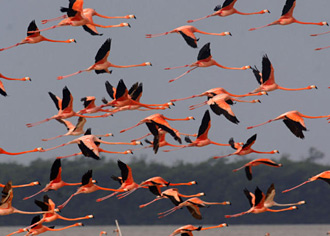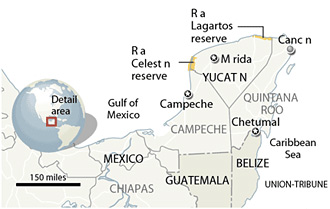 |
 |
 |
 Editorials | Environmental | May 2006 Editorials | Environmental | May 2006  
In the Pink
 S. Lynne Walker - Copley News Service S. Lynne Walker - Copley News Service


| | Flamingos fly along the northern coast of Mexico's Yucatan peninsula. The long-limbed birds can travel great distances, with some migrating between Mexico and Cuba and southern Florida. (CNS/Luis J. Jimenez) |
Rio Lagartos, Mexico – A splash of color spills across the sky. Flamingos, hundreds of flamingos with wings spread wide, stream along the Yucatan coast in a river of iridescent coral and rose.

Mexico's flamingo population is on the rise, rescued from the threat of extinction by a Yucatan-based environmental group.

In 1999, an estimated 26,000 flamingos lived on Yucatan's northern coast, and their numbers were falling. Less than a decade later, some 54,000 can be found in the salty lagoons, courting, mating and raising new generations.

“We are helping them survive,” said Rodrigo Migoya, a biologist who heads the environmental group Niños & Cr 7/8as, Kids & Critters. “This is good for everybody because our own survival depends on the preservation of natural habitats.”

Yucatan is home to Mesoamerica's only flamingo population living in the wild. Although flamingos can fly great distances, sometimes migrating as far as Florida's Everglades, they rarely leave Yucatan's warm, shallow inland waters.

The fragile birds have struggled against predators, both human-made and natural.

Their only defense is to cluster together in colonies, with each flamingo ever watchful and ready to sound a loud, squawking alarm that sets off a hurried flight if danger draws too close.

 Until the Mexican government declared two of Yucatan's flamingo feeding and nesting sites – Ria Lagartos and Ria Celestun – off limits in 1979, humans were their worst enemy. Maya Indians collected the birds' eggs to make a pastry known as flamingo bread. Hunters shot them and sold the meat for a handful of pesos. Until the Mexican government declared two of Yucatan's flamingo feeding and nesting sites – Ria Lagartos and Ria Celestun – off limits in 1979, humans were their worst enemy. Maya Indians collected the birds' eggs to make a pastry known as flamingo bread. Hunters shot them and sold the meat for a handful of pesos.

The government halted those practices with tough enforcement and harsh penalties – but then nature began to wreak havoc on the flamingo population.

In 2000, a jaguar frightened away adult flamingos that were caring for the nests, leaving more than 2,000 of that year's eggs unhatched. The next year, flooding forced parents away from the nests and 8,200 eggs were lost. In 2002, flooding destroyed another 8,500 eggs.

Since each mating couple produces only one egg per season, the losses were devastating.

Kids & Critters, working with government biologists, spent $45,000 to rebuild one of the peninsula's most important flamingo nesting sites to protect it from flooding. An island in Ria Lagartos Biosphere Reserve, called Punta Mecoh, or Flamingo Point, is now covered with a fresh layer of shell fragments and claylike sand that flamingos use to build their nests. Last year, 10,000 flamingo chicks were hatched in the reserve.

The organization, which was founded in 1999, has been so successful with its flamingo effort that Migoya and his 11-person team are attempting similar programs in other Mexican wildlife reserves.

Working with a $300,000 annual budget that comes from private donations and government funding, they are trying to protect the habitats of the monarch butterfly in Michoacan, the quetzal bird in Chiapas and a cactus indigenous to the state of Hidalgo.

Migoya, a shy, soft-spoken scientist whose office is decorated with toy flamingos, worries about the long-term prospects for plants and wildlife in Mexico, which ranks fourth in the world in number of indigenous species. His goal is to expand the organization's work to 20 more biological reserves.

“Human beings are becoming very selfish because we don't want to live with other species,” he said. “What our organization would like to do in every place is protect the species that are there.”

Migoya acknowledged this will not be easy.

“You have to go slow. People have to be convinced,” he said. “In Rio Lagartos, people did not like the idea of protecting habitats. But over time, we have seen a dramatic change. As we heightened their awareness, they have begun to protect their resources.”

Today, the stunning range of species in Ria Lagartos attracts visitors from around the world, bringing new sources of income to the impoverished Maya who live there.

Alex Wolfe, a 42-year-old filmmaker from New York, recently took a day trip to Ria Lagartos, then extended his stay after discovering the reserve's vast array of wildlife.

“There are all kinds of endemic species and endangered species here. It's more than just the flamingos,” said Wolfe, who lived for several years in San Diego. “These people have really developed a very high consciousness of these fragile ecosystems and the importance to their lives here.”

Ismael Navarro, 27, is a Rio Lagartos resident who has become a confirmed environmentalist. The son of an illiterate fisherman, Navarro speaks four languages as he guides tourists down the reserve's waterways in his motorboat.

He has attended more than two dozen government-sponsored workshops to learn to identify the reserve's species. He uses piercing whistles and calls to bring birds close to his boat. He reaches into the water and pulls out a horseshoe crab. He slows for a better look at a crocodile sunning itself on a tree trunk near the shore.

“You have to know how to exploit an opportunity without damaging the environment,” Navarro said.

Suddenly, he slows the motor and points at a shimmering line of coral and rose separating the water from the horizon.

“Doesn't that make your heart beat faster?” he asked. In the distance, several hundred flamingos were grazing for food in waist-high water. “Even though I see it all the time, I never stop enjoying it.”

Ancient lineage

For as long as anyone can remember, flamingos have congregated in the waterways running through Ria Lagartos. The food they need to maintain their beautiful pink plumage – algae, larvae and crustaceans high in beta carotene pigments – is plentiful; the water is calm; and it is a safe place that humans rarely visit.

As the flamingos wade through the salty water, they utter a soft, contented murmur, not unlike the sound of a faraway radio. When they are frightened, the murmur shifts to a cry of alarm and they run on the surface of the water until their huge wings – often spanning 65 inches – lift them into the air.

Scientists believe that flamingos, which are among the most ancient bird families, have been living this way for millions of years. Fossils similar to those of the modern-day birds date back 30 million years. Some of the fossils were discovered in parts of Europe, North America and Australia, where flamingos are no longer found, suggesting they once congregated on several continents.

Flamingos were drawn to Yucatan because of inland waterways that some scientists believe were created when a huge meteor struck the peninsula about 65 million years ago and led to the extinction of dinosaurs.

“The Yucatan peninsula is like a Gruyere cheese,” explained Felipe Be, a government biologist who runs Ria Lagartos Biosphere Reserve. “The surface is flat, and beneath the surface are caverns that collect water,” which are linked to freshwater-filled limestone sinkholes called cenotes.

Navarro was a 6-year-old fishing with his father when he first spotted the strange, pink bird and asked its name.

Since that day, Navarro has loved flamingos. Yet it was only as an adult that he began to realize he could protect them. His guide work has made it possible for him to support his family while living inside the 200-square-mile reserve.

Still, Navarro is one of only three Rio Lagartos residents who have earned a government credential to become an ecotourism guide.

“The government gave courses, but no one attended,” he said. “It is really sad. There should have been more.”

Navarro has been tempted by offers to leave Rio Lagartos for nearby beach cities like Cancun or Playa del Carmen, but the lure of working among nature's most exotic creatures has convinced him to stay.

As he steered his boat toward flamingos silhouetted in the setting sun, he lowered his voice, careful not to frighten the birds.

“If I don't protect them, who will?”

Communing with chicks

It is mating season, and the flamingos are engaged in a courting dance, an elegant waltz of swaying heads and spread wings. Their feathers have changed to a sensual orange, and they preen themselves in an unabashed effort to attract a partner.

In the flamingo world, both the female and the male participate in the raising of chicks. They build their clay nests together, scraping mud and shells into a 2-foot-high cone and lining it with their feathers.

They share the duties of protecting their egg during the 30-day incubation period. When the female leaves the nest to eat, her male partner sits on the egg. When she comes back, he leaves.

The parents learn to identify the sounds of their chick while it is still in the egg. Because flamingos are vocal, the chirps of the still-growing chick help them find their offspring once it has hatched.

In June, the chicks will break out of their shells covered with soft, white, downy feathers that make them look more like ducks than flamingos.

The reserve's adult flamingos are so amorous this year, and the nesting sites so favorable, that Migoya predicted several thousand new chicks will be testing their sea legs in Ria Lagartos by summer.

As their numbers grow, Migoya said scientists must be careful not to once again put Mexico's flamingos at risk by overpopulating the reserve.

“How many flamingos can we have in the habitat? Nature has a limit,” he said.

But he is convinced that eventually humans and flamingos will learn to live together.

“Once people start feeling like they are part of a project, it becomes contagious,” he said. “Little by little, we are accomplishing something.” | 
 | |
 |



